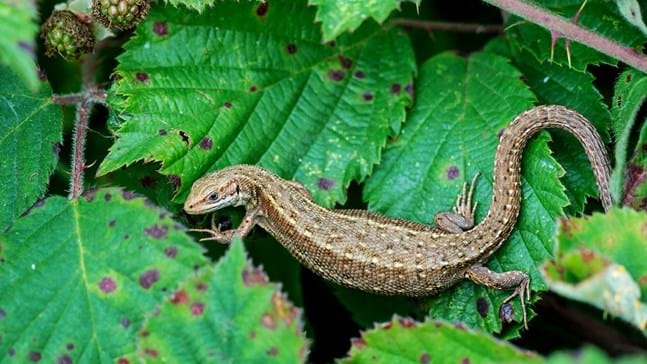REPTILES living on Exmoor currently comprise two snake and two lizard species - one is the slow-worm. You could be forgiven for thinking that the slow-worm is a snake too, but in fact it’s technically a lizard!
Reptiles are cold-blooded and need an external source of heat to regulate their body temperature. They aid this process by basking in the sun during the warmer months, and hibernating over the colder periods, often in groups of individuals of the same species.
We have seen a juvenile grass snake curled up with slow-worms during the summer, so perhaps this can happen during hibernation too.
Reptiles are covered in scales or bony plates that are shed periodically to allow for growth, so juveniles shed more frequently than adults. Lizards shed their scales in small pieces but snakes in one piece. Reptiles which have recently shed their skin often have an iridescent sheen.
The two lizard species found on Exmoor are the slow-worm (Anguis fragilis) and the common lizard (Zootoca vivipara).
Slow-worms look like snakes and are often mistaken for them, but they are actually legless lizards with shiny pale brown or golden scales. Older males occasionally sport blue spots but they lack the dark brown sides that females show, along with a stripe along their backs.

With a length of between 40-70 cm and a weight of 20-100 grams, slow worms are not very large, yet they have an amazingly long lifespan of 20 to 30 years - one was even reported to live for 52 years in captivity (but that was many years ago, so was never verified).
In reality, many never reach their full lifespan. Slow-worms are on the menu for many mammals, birds and adders, and numbers also get killed on our roads.
However, slow-worms do have a trick or two up their sleeves to protect themselves from being caught and eaten. I can personally testify that they are far from slow when it comes to escaping predators, having seen one escaping at speed from a cock pheasant.
Should slow-worms feel threatened, their first line of defence is to freeze, then to flee. If caught they defecate, and if that doesn’t deter the assailant, they can detach their tail which will wriggle rapidly in the hope that the predator will be distracted long enough to let the slow-worm escape.
This process is known as autotomy and is used by many lizard species. The tail stump quickly heals and eventually starts to re-grow.
Slow-worms hibernate buried in the soil from November to early March. After emerging and warming up sufficiently, they set about searching for prey: usually slugs. These, besides being horribly slimy, can be difficult to swallow so the slow-worm aids ingestion by burrowing into the soil, helped by its shiny scales.
Friction from the soil removes the slime from its prey. What a clever and useful animal to welcome into your gardens, where they are often found, a gardeners’ friend indeed!
Love-making slow-worm style is a lengthy and rather brutal affair with the male biting the female’s head or neck and holding her whilst they entwine and copulate for up to 10 hours.
Up to 12 tiny young, about four cms long, are born in August or September. By October hibernation begins again.
Placing a corrugated iron or other metal sheet in a sunny location in your garden will attract slow-worms and allow them to warm up more quickly.

Common lizards are the species you are most likely to spot on Exmoor. They frequently bask in sunny spots on logs, stony ground, tree trunks with gnarly bark or clumps of flattened vegetation in the spring and autumn, flattening themselves to increase the surface area exposed to the sun.
They will scuttle away into denser vegetation with a rustling noise if disturbed.
Common lizards reach a size of 10-15cms - half of which is made up of their tails. The tail, as with slow-worms, can be shed to escape predation from the many birds, mammals and adders that feed on them.
Colours vary from black to vivid green although most are varying shades of brown, striped and speckled for camouflage. Males have brightly coloured underbellies: yellow or orange with dark spots.
Female underbellies are pale and plain. Emerging from hibernation is usually a communal affair in March or April. Common lizards seek out their invertebrate prey using sight, scent and sound. They bite along the length of the hapless victim before swallowing it whole, usually head first, in common with most reptiles.
Females mate several times with one or more males in April or May. The birth of three to eleven young is generally three months later, in July. Sunshine helps the young to hatch. Sometimes they even hatch inside the mother and wriggle out. Lizards should live for five to six years, provided they can escape being eaten.
All our British reptiles are sadly under threat, with destruction of their habitat for development, intensive farming and busy roads, on which many get run over.




